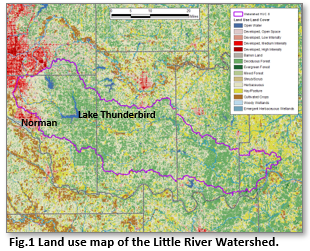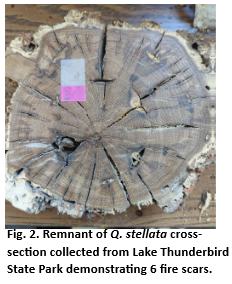
Historical Fire Regimes Reconstruction and Future Fire Regimes in the Upper Little River Watershed
EPSCoR Update - September 2023

The Upper Little River Watershed (ULRW) in the cross-timbers ecoregion in central Oklahoma drains into Little River, which was dammed to form Lake Thunderbird (Fig. 1) that provides drinking water for Norman, Midwest City, and Del City. In the past few decades, the ULRW has experienced water resource problems due to climate change, woody plant encroachment as well as urbanization associated with increasing human populations. Future increases in subseasonal to seasonal extreme weather events, droughts, and changes in wildfire regimes will likely affect the water availability and severity of water quality issues in ULRW.
“Fire was an important forcing factor in shaping forest structure and development historically. Changes in fire frequency, mainly due to urban development and fire suppression efforts, has led to a change in forest species composition and structure,” Dr. Chad King said.
 Hence, Dr. Chad King, assistant chair, and professor of Biology at University of Central Oklahoma, worked with his undergraduate research assistant, Mariah Kalka, to reconstruct the historical fire regimes and project future fire regimes for Lake Thunderbird, Little River Watershed.
Hence, Dr. Chad King, assistant chair, and professor of Biology at University of Central Oklahoma, worked with his undergraduate research assistant, Mariah Kalka, to reconstruct the historical fire regimes and project future fire regimes for Lake Thunderbird, Little River Watershed.
“We documented fire occurrences in the 20th century using dendrochronology and projected future wildfire regimes under changing climate conditions. A historic fire chronology was developed using the collection of cross-sections from remnant wood, stumps, and snags of post oak (Quercus stellata) from four sites at Lake Thunderbird State Park during Fall 2022,” King said.

“Samples of remnant wood cross sections (Fig. 2) were selectively collected as close to the ground as possible to capture the greatest number of fire scars. Following cross-dating of remnant wood, we identified fire scars and were assigned calendar years of scarring based on cross-dating analysis”, King added.
The research team used FHAES computer program to analyze characteristics of the fire chronology including fire frequency (mean fire interval), fire severity (fire years in which >25% samples were scarred), and the season of fires. The team documented the fire history of the Lake Thunderbird area for the period 1806 to 1964. Fire frequency was also assessed pre-1900 and post-1900.
“Approximately 45.1% of Q. stellata remnant wood samples had at least one fire scar. A total of 71 fire scars that occurred from 35 fire events were dated between 1806 and 1964. The earliest fire we documented at the study sites was in 1806 and the earliest fire year with more than one scarred tree was 1810.The most severe fire years (based on >25% of samples that were scarred in same year) included 1912, 1918, 1920, 1923, 1931, 1940, 1953, 1954, and 1956. The shortest interval between fire years was one year (1939 to 1940; 1953 to 1954) and the longest was 18 years (1855 to 1873),” King said.
The research team revealed that fires occurred, on average, every 9 years during pre-European settlement (pre-1900). However, higher fire frequencies were detected post-1900 with a mean fire interval of 2.52 years and an overall median fire interval of 4.65 years.
“While it is unclear the origin of the fires in our part of the study, it is likely that these were human-ignited fires. Given the relatively high frequency of fires detected during the post-European settlement period (post-1900), this has potential ramifications in terms of climate change, increasing longevity and severity of droughts. Maintaining high fire frequencies coupled with climate factors has the potential of increasing fire severity,” King said.
“We also did not detect any additional fires after 1964 based on our historic fire chronology for Lake Thunderbird. The absence of fire in this area, along with other parts of the Cross Timbers Ecoregion has resulted in increasing fuel loads that increases the potential fire severity. The result would be removal of existing forest cover and increased erosion into surrounding watersheds that affects water quality,” King said.
____________
This work was initiated with support from the National Science Foundation under Grant No. OIA-1946093 through OK NSF EPSCoR as part of the Seed Grant awarded to Drs. Jia Yang and Chris Zou.
